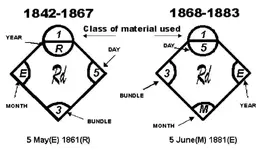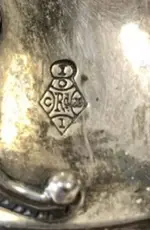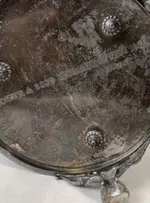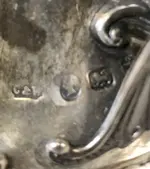You are using an out of date browser. It may not display this or other websites correctly.
You should upgrade or use an alternative browser.
You should upgrade or use an alternative browser.
Help confirm if this is sterling
- Thread starter cheech
- Start date
testing123
Bronze Member
- Joined
- Mar 29, 2009
- Messages
- 2,359
- Reaction score
- 1,986
- Golden Thread
- 0
- Location
- United States
- Detector(s) used
- CTX 3030, TDI SL
It looks like English sterling? I see possibly Queen Victoria which would have been made during her reign, the lion passant (spelling?) indicating sterling, and the anchor for Birmingham. Is there a single letter stamped on there?
Holt0222
Hero Member
- Joined
- Sep 24, 2015
- Messages
- 524
- Reaction score
- 417
- Golden Thread
- 0
- Location
- Washington
- Primary Interest:
- All Treasure Hunting
I think it is C & W
- Joined
- Dec 23, 2019
- Messages
- 6,375
- Reaction score
- 20,279
- Golden Thread
- 0
- Location
- Surrey, UK
- Primary Interest:
- All Treasure Hunting
Yes, that’s for sure a piece of Sterling silver by Lister & Sons of 12, 14 and 16 Mosley Street, Newcastle in England. William Lister (snr.) established the business, later inherited by his sons Clement and William (jr.), so the sponsor’s mark will be C&W for Clement and William (jr.)
Although there was an assay office in Newcastle, you could use any assay office you wished and this piece was assayed in Birmingham (the anchor, shown sideways and partly tucked behind some scrollwork in your picture). Lister also used the London assay office.
The full compulsory hallmark set should be Lion passant (Sterling silver), Anchor (Birmingham office), Duty Mark (Victoria’s head), and date letter (shown below as ‘N’ for 1862). The marks don’t have to be in that order, but date letters are almost always last in the sequence and probably your date letter is at the end, just out of view.

It might not be a letter ‘N’ though, but will probably be either N, O or P for one of the years 1862, 1863 or 1864 respectively.
Additionally, your piece has two other voluntary marks. There’s the maker in full as “Lister & Sons, Newcastle on Tyne 1862, Fecerunt”. The word ‘fecerunt’ is Latin for ‘made this’ and is a bit pretentious. It’s usually seen as part of an artist/craftsman signature. Then, it also has what is known as a ‘diamond mark’ or ‘lozenge mark’. These marks indicate that a design has been registered by the Patent Office under the terms of the ‘Ornamental Designs Act 1842’ to give an added layer of protection against copying.
The registration provides three years of copyright protection so, although your piece carries an actual date of 1862, the assay date letter could, as I said, be a few years later. These marks aren’t just applicable to silver and, when present, are a very useful way of dating pieces that may not otherwise have any indication (base metal and silverplate for example). The anatomy of your mark follows the format shown on the left below:

At the top is the class of material to which the design relates, which can be in Roman numerals or Arabic numerals. The Roman ‘I’ or Arabic ‘1’ is for metal (II is for wood, III for glass and so on up to XIII for textiles). Below that is a letter code for the year the design was registered (‘O’ for 1862 in your case). At the left is a letter code for the month (‘C’ is for January in 1862) and at the right is the day of the month (looks like it might be 28th January). Note that the letter codes themselves don’t follow a logical sequence and you have to look them up from the relevant data tables.
At the very bottom is the ‘bundle number’ (also known as a ‘package number’) which indicates how many different items are covered by the design registration. In your case, just one. In the centre, the ‘Rd’ is short for ‘Registered’.
Although there was an assay office in Newcastle, you could use any assay office you wished and this piece was assayed in Birmingham (the anchor, shown sideways and partly tucked behind some scrollwork in your picture). Lister also used the London assay office.
The full compulsory hallmark set should be Lion passant (Sterling silver), Anchor (Birmingham office), Duty Mark (Victoria’s head), and date letter (shown below as ‘N’ for 1862). The marks don’t have to be in that order, but date letters are almost always last in the sequence and probably your date letter is at the end, just out of view.

It might not be a letter ‘N’ though, but will probably be either N, O or P for one of the years 1862, 1863 or 1864 respectively.
Additionally, your piece has two other voluntary marks. There’s the maker in full as “Lister & Sons, Newcastle on Tyne 1862, Fecerunt”. The word ‘fecerunt’ is Latin for ‘made this’ and is a bit pretentious. It’s usually seen as part of an artist/craftsman signature. Then, it also has what is known as a ‘diamond mark’ or ‘lozenge mark’. These marks indicate that a design has been registered by the Patent Office under the terms of the ‘Ornamental Designs Act 1842’ to give an added layer of protection against copying.
The registration provides three years of copyright protection so, although your piece carries an actual date of 1862, the assay date letter could, as I said, be a few years later. These marks aren’t just applicable to silver and, when present, are a very useful way of dating pieces that may not otherwise have any indication (base metal and silverplate for example). The anatomy of your mark follows the format shown on the left below:

At the top is the class of material to which the design relates, which can be in Roman numerals or Arabic numerals. The Roman ‘I’ or Arabic ‘1’ is for metal (II is for wood, III for glass and so on up to XIII for textiles). Below that is a letter code for the year the design was registered (‘O’ for 1862 in your case). At the left is a letter code for the month (‘C’ is for January in 1862) and at the right is the day of the month (looks like it might be 28th January). Note that the letter codes themselves don’t follow a logical sequence and you have to look them up from the relevant data tables.
At the very bottom is the ‘bundle number’ (also known as a ‘package number’) which indicates how many different items are covered by the design registration. In your case, just one. In the centre, the ‘Rd’ is short for ‘Registered’.
tamrock
Platinum Member
Interesting mark. I've seen those on mostly old ceramics. Good find Creech, but it sure be neat to see the whole piece.
captain flintlock
Hero Member
- Joined
- Jul 21, 2015
- Messages
- 942
- Reaction score
- 1,036
- Golden Thread
- 0
- Detector(s) used
- Tesoro
- Primary Interest:
- All Treasure Hunting
Yes definitely English Sterling. What a cool find and I agree with tamrock. Let’s see some pics of the whole darn thing. That will also look stunning all polished up.
Similar threads
- Replies
- 11
- Views
- 2K
Users who are viewing this thread
Total: 1 (members: 0, guests: 1)






